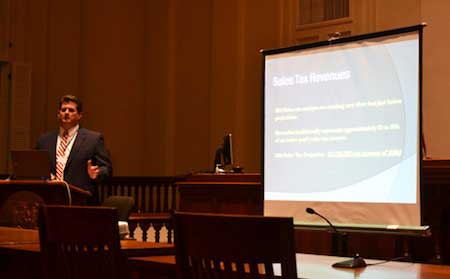Orleans and county administrator extend contract for 5 years
Chuck Nesbitt has helped county reduce workforce, tackle many infrastructure projects

File photos by Tom Rivers: Chuck Nesbitt, the Orleans County chief administrative officer since 2006, is pictured to a budget hearing at the County Courthouse in December 2013.
ALBION – The county’s top administrator has signed a contract extension to serve in the post for another five years.
Chuck Nesbitt, the chief administrative officer since 2006, and the Orleans County Legislature approved the five-year contract last week.
“Quite frankly I think he has been outstanding,” said David Callard, the County Legislature chairman.
Nesbitt has led a push to streamline county government, while tackling a series of infrastructure projects with county buildings, roads, bridges and culverts, while also establishing a partnership with Genesee County for public health.
“He plans a very conservative budget and we stick to the budget,” Callard said. “Chuck is good not only in short term operational improvements but in long-term visionary planning.”
Callard said Nesbitt was influential in a $7 million upgrade to the county’s emergency radio system. He also has been a key in the push to expand broadband Internet in rural parts of Orleans, a shared initiative with Niagara County.

Jail Superintendent Scott Wilson, left, and Orleans County Chief Administrative Officer Chuck Nesbitt stand on a new roof on top of the county jail in this file photo from August 2013. The roof was part of more than $1 million in upgrades at the jail.
“Some ideas may take 3, 5, 7 years to bring into fruition,” Callard said.
The county is currently leading a study and discussion for shared or consolidated law enforcement services in the county.
Nesbitt is an Albion native who lives in his hometown. His father Charlie is a former state assemblyman.
Nesbitt is active in the New York State Association of Counties, currently serving as the group’s second vice president. He is also president of the NYS County Administrators’ Association.
Callard said those roles have given Nesbitt insights to successes in other counties.
“Those contacts are invaluable,” Callard said. “We like good ideas. Some pop on the local level and some pop on the statewide level.”
Nesbitt is currently paid $110,134. His contract gives him 2 percent annual increases. From 2018-2020, he is also eligible for an additional COLA (cost of living adjustment) in the management contract. That is typically about 2 percent. The COLA isn’t included in the final two years of the contract.
Callard noted that Nesbitt does the job, overseeing an annual budget of about $65 million, without any assistant county administrators.
“He has to assume more responsibilities,” Callard said. “He is doing more than one person’s job.”

Orleans County officials were joined by State Sen. George Maziarz in turning a ceremonial shovel of dirt during a ground-breaking for a new $7.1 million emergency communications system on Jan. 15, 2014. Pictured outside the Emergency Management Office include, from left: County legislators John DeFilipps, Ken DeRoller, Lynne Johnson, Bill Eick, Eileen Banker (chief of staff for Assemblyman Steve Hawley), Maziarz, County Chief Administrative Officer Chuck Nesbitt, Legislature Chairman David Callard, and Paul Wagner, the former EMO director.
Nesbitt said he is happy in his job and to stay committed to Orleans County for another five years. He and his wife Elissa have two children, Jane, 5; and Benjamin, 3.
He said the seven-member County Legislature and team of department heads are all hard-working and focused on delivering quality service at a low cost to the taxpayers.
“We have a group of hard workers committed to doing best thing for the county,” Nesbitt said.
The county has reduced the size of its government from 455 full-time, 157 part-time and 9 seasonal employees in 2005 to the current 324 full-time, 90 part-time and 11 seasonal.
The county sold its nursing home and has streamlined other departments.
“We’ve reduced the size but the complexity of county government hasn’t gotten easier,” Nesbitt said. “It’s become harder.”





































































